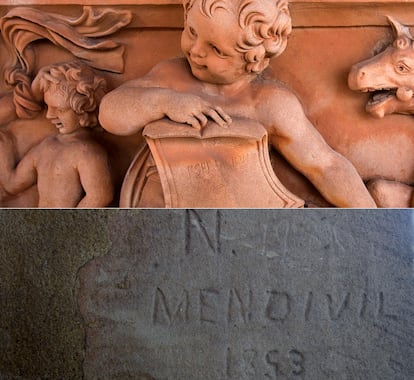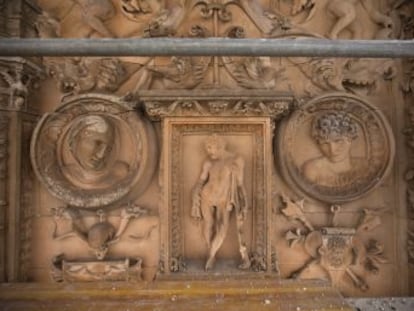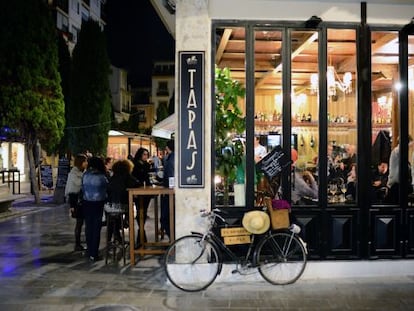Busted: student who vandalized Salamanca University facade in 1853
Restoration has helped experts solve mystery behind unsightly graffiti on iconic Spanish building
The culprit was Nicomedes de Mendívil, a third-year student at the Madrid School of Architecture. In May 1853 he went on a field trip to the historic University of Salamanca with classmates and his professor, the famous Spanish architect Francisco Jareño.

When the class arrived to contemplate the university’s famous facade, which is one of the best examples of the Spanish Plateresque (late 15th and 16th centuries) architectural style, they were able to get a close-up view by climbing on a scaffolding set up for the occasion.
Nicomedes, the presumptive scoundrel, then decided to do what hundreds of generations of disrespectful travellers had done before him – leave behind a reminder of his presence. So he snuck up the scaffolding and carved ‘Espedición 1853’ on a stone block and ‘Espedicion’ and some other unidentified signs on a cherub’s shield, in order to immortalize his special field trip.
A few other quirky discoveries were made during the restoration process
Now, 166 years later and thanks to an integral restoration of the facade that took four months, 50 workers and €590,000, experts have finally discovered the identity of Nicomedes, the 19th-century vandal.
“We took down the roofing in the room of incunabulum and that’s where we found a stone block with the inscription ‘N. Mendivil 1853’,” said Eduardo Azofra, a professor of art history at Salamanca University, in a conversation with EL PAÍS.
Azofra said that after discovering the name carved into stone, experts consulted a 2015 report written by another professor, Antonio Casaseca, about the infamous outing—the ‘Espedición’ of 1853. That report found that there was indeed a classroom expedition that year, with the purpose of having students bring home drawings of historical buildings. The antique logs even recorded the names of the students—including Nicomedes’. Finally everything came together, and the compulsive carver was busted, albeit a century and a half too late.
“Charles Clifford, the famous Welsh photographer, was also there, under the service of Queen Elizabeth II,” added Azofra. He said that during that outing Clifford took “the oldest known images of Salamanca.”

This week, the restoration is wrapping up and the scaffolding will start to come down. Visitors will soon be able to have a clear view of the facade, as they hope to spot the famous frog concealed among other ornate figures carved into the stone.
Although the case of the graffiti has been solved, the facade continues to puzzle experts. They still don’t know the exact date of construction (estimated to be between 1512 and 1529), which king or aristocrat ordered it, which architect designed it, or which sculptors worked on it.
But a few other quirky discoveries were made during the restoration process. Experts found several hidden architectural stencils called ‘monteas,’ and a carving that they think was used as the playing board for ‘alquerque’—an ancient game believed to be the predecessor of checkers.
The restoration experts have also repaired damage caused by rain, wind and bird droppings. Among other improvements, sensors have been installed to help protect the monument from both natural and human-induced decay.
English version by Alyssa McMurtry.
Tu suscripción se está usando en otro dispositivo
¿Quieres añadir otro usuario a tu suscripción?
Si continúas leyendo en este dispositivo, no se podrá leer en el otro.
FlechaTu suscripción se está usando en otro dispositivo y solo puedes acceder a EL PAÍS desde un dispositivo a la vez.
Si quieres compartir tu cuenta, cambia tu suscripción a la modalidad Premium, así podrás añadir otro usuario. Cada uno accederá con su propia cuenta de email, lo que os permitirá personalizar vuestra experiencia en EL PAÍS.
¿Tienes una suscripción de empresa? Accede aquí para contratar más cuentas.
En el caso de no saber quién está usando tu cuenta, te recomendamos cambiar tu contraseña aquí.
Si decides continuar compartiendo tu cuenta, este mensaje se mostrará en tu dispositivo y en el de la otra persona que está usando tu cuenta de forma indefinida, afectando a tu experiencia de lectura. Puedes consultar aquí los términos y condiciones de la suscripción digital.
More information
Últimas noticias
The complicated life of Francesca Albanese: A rising figure in Italy but barred from every bank by Trump’s sanctions
Pinochet’s victims grapple with José Antonio Kast’s rise in Chile
Reinhard Genzel, Nobel laureate in physics: ‘One-minute videos will never give you the truth’
How Japan is trying to avert ‘digital defeat’
Most viewed
- Pablo Escobar’s hippos: A serious environmental problem, 40 years on
- Reinhard Genzel, Nobel laureate in physics: ‘One-minute videos will never give you the truth’
- Why we lost the habit of sleeping in two segments and how that changed our sense of time
- Charles Dubouloz, mountaineering star, retires at 36 with a farewell tour inspired by Walter Bonatti
- The Florida Keys tourist paradise is besieged by immigration agents: ‘We’ve never seen anything like this’











































